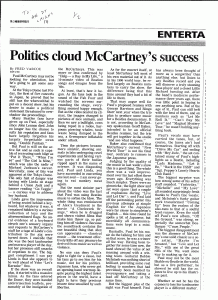Japan, Korea and the Gangnam void
By Fred Varcoe
There’s something distinctly odd about Japan’s cultural relationship with South Korea. Of course, with around a million Koreans or people of Korean lineage living in Japan (the Koreans would claim around 120 million, but that’s a different story), it should be no surprise that there is a strong link between the two. Head to the area between Shin Okubo/Hyakunin-cho and Kabukicho in Shinjuku Ward and you will be overwhelmed by Koreana. You can’t move for Korean shops, Korean restaurants, Korean pop culture and Korean people.
When I lived in that area between 1987 and 1992, there was nothing there. And I mean nothing. At that time, Japanese culture was effectively banned in South Korea – no pop music, no films, nothing – and it seemed like it was a two-way affair. Japan, too, wasn’t exactly going out of its way to understand the culture of its closest neighbour (despite the presence of plenty of Korean hostesses where I lived).
Following the easing of restrictions on Japanese culture (which was, of course, always available in the bootleg markets of Seoul and other cities), the two countries slowly opened up to each other. Japanese bands were already becoming popular in Korea, while “Winter Sonata” heralded a tsunami of dreadful dramas into Japan. Koreans have become big stars in Japan, while Japanese are free to exploit the smaller Korean market.
Japanese pop fans have realised that Korean bands and stars can out-sing and out-dance the domestic versions (or at least equal the many “Japanese” stars of Korean descent). Other Asian countries have followed suit. The Koreans are everywhere.
PSY is everywhere.
Who’s he?
The pudgy 34-year-old has taken the world by storm with his quirky dance hit “Gangnam Style,” racking up half a billion views on YouTube and soaring to the top of the charts in the U.K., the United States and a host of other countries. He’s now a worldwide star.
A worldwide star that most people haven’t heard of in Japan.
The anomaly doesn’t make sense. Japan has been mainlining Korean culture for a decade now and doesn’t seem to be able to kick the habit. However, a recent reawakening of the Dokdo/Takeshima island dispute has put the right-wing lunatics back on the street and TV stations have been put under pressure to lay off Korean culture. Even Fuji TV, known as a right-wing channel, was apparently “warned” to be less accommodating to Korean programs and to show more Japanese crap.
Politicians from both countries have fanned the flames in irresponsible ways. South Korean President Lee Myung-Bak’s ill-advised trip to the islands sparked the latest round of insults and many Japanese have been happy to return the insults with their warped version of history. The Koreans are in possession of the islands and aren’t going to give them up. The Japanese have a weak claim to them and aren’t going to do anything to try and reclaim them, apart from fruitless gestures and ineffective legal measures. So the catcalling is just that.
But it may be that there is some discrimination against PSY for being the world’s most visible Korean. Some people claim not to like “Gangnam Style,” but not many. And it should be right up Japan’s alley – great tune, good beat, stupid dance, funny and fun. What’s not to like?
Some say PSY hasn’t promoted the song in Japan. HELLO!!!?! Half a billion people have seen it on YouTube. It shouldn’t need promoting. It’s a worldwide phenomenon; you’d think that any media organisation must report on it. How could they ignore it? But I haven’t seen it mentioned on Japanese TV (which, admittedly, I try to avoid) and when I polled 50 university students, only one of them knew it – or admitted to knowing it.
PSY reportedly was planning on heading to Japan at the end of September and even planning to do a special Japan version of his song (“Roppongi Style”), but the trip didn’t come off. No reason has been given. One theory is that he was concentrating on doing a deal with Justin Bieber’s management in the U.S. But one factor that may be preventing PSY from coming here is a drugs bust in South Korea in 2001. He was busted for smoking marijuana. Apparently, the usual drill for South Korean parents in such situations is to head down to the cop shop, fall to their knees and beg forgiveness for their child. PSY’s parents apparently just shrugged and said, “Yep, that sounds like our son.”
PSY also had trouble with his compulsory military service. According to Wikipedia:
“PSY served his mandatory military service as a technician in a venture firm from 2003 to 2005. After evidence came to light that revealed that PSY hadn’t properly carried out his duty during his service as a technician, he was re-drafted to serve as a soldier in the ROK Army in August 2007. After being discharged in the summer of 2009, PSY said he had learned a lot through this experience. He said he also felt the weight of his responsibility to his wife and twin daughters, born two months before he headed off to the ROK Army boot camp.”
PSY has been labelled “K-Pop” but he’s not really part of the K-Pop setup. He’s not pretty, he’s not slim, he doesn’t look like he’s been surgically modified and he’s not young – generally prerequisites for success in Japan (and Korea). But he does have talent and has been successful over the years. More to the point, he’s funny and an iconoclast. He gets irony, which the Japanese haven’t managed to invent yet. Maybe the Japanese just don’t get him.
Apkujong (no) style
“Gangnam Style” parodies the young, rich and stupid who flash their brand names in the meat markets of Seoul. PSY should know; he’s one of them. Well, he’s a rich, Gangnam boy. Actually, Gangnam is a large area south of the Han River in Seoul. The ground zero for the rich dicks PSY parodies is Apkujong. Here’s what I wrote about Apkujong for The Japan Times 10 years ago:
“Apkujong
Part of the Gangnam area, but merits an entry in its own right as it’s the trendiest part of town. Or, to put it in the vernacular, it’s full of tossers with more money than taste and posers with no taste at all. Apkujong is a little bit Ginza, a little bit Regent’s Street, a little bit Beverly Hills. … While you will still get your hamburger joints (McDonald’s, Kentucky, Hard Rock Cafe, etc.) and family restaurants (Bennigans, Thank God It’s Friday), you can find several classy eating establishments, bars and cafes. Of course, there’s nothing more irritating than seeing a bunch of clueless dorks with cash pretending they’re better than everyone else, but if you can ignore the cream of South Korea’s jerks, you can find some decent food in the area. Apkujong is BIG on fashion designers. You have been warned.”
According to an AP report: “ ‘The song explores South Koreans’ ‘love-hate relationship with Gangnam,’ said Baak Eun-seok, a pop music critic. The rest of South Korea sees Gangnam residents as everything PSY isn’t, he said: good-looking because of plastic surgery, stylish because they can splurge on luxury goods, slim thanks to yoga and personal trainers.
‘PSY looks like a country bumpkin. He’s a far cry from the so-called Gangnam Style,’ Baak said. ‘He’s parodying himself.’ ”
Well, good luck to him. PSY obviously can do without Japan. Japan, on the other hand, desperately needs someone like PSY who can recognize and parody the buffoonery in Japanese society and politics and entertainment. We don’t need no Beat Takeshi, as Pink Floyd might have said. It’s another brick in the wall that Japan loves to live behind.
The world’s gain is Japan’s loss.
English Translation of “Gangnam Style” (from the web):
Oppa is Gangnam style
Gangnam style
A girl who is warm and human during the day
A classy girl who know how to enjoy the freedom of a cup of coffee
A girl whose heart gets hotter when night comes
A girl with that kind of twist
I’m a guy
A guy who is as warm as you during the day
A guy who one-shots his coffee before it even cools down
A guy whose heart bursts when night comes
That kind of guy
Beautiful, loveable
Yes you, hey, yes you, hey
Beautiful, loveable
Yes you, hey, yes you, hey
Now let’s go until the end
Oppa is Gangnam style, Gangnam style
Oppa is Gangnam style, Gangnam style
Oppa is Gangnam style
Eh, Sexy Lady, Oppa is Gangnam style
Eh, Sexy Lady oh oh oh oh
A girl who looks quiet but plays when she plays
A girl who puts her hair down when the right time comes
A girl who covers herself but is more sexy than a girl who bares it all
A sensible girl like that
I’m a guy
A guy who seems calm but plays when he plays
A guy who goes completely crazy when the right time comes
A guy who has bulging ideas rather than muscles
That kind of guy
Beautiful, loveable
Yes you, hey, yes you, hey
Beautiful, loveable
Yes you, hey, yes you, hey
Now let’s go until the end
Oppa is Gangnam style, Gangnam style
Oppa is Gangnam style, Gangnam style
Oppa is Gangnam style
Eh, Sexy Lady, Oppa is Gangnam style
Eh, Sexy Lady oh oh oh oh
On top of the running man is the flying man, baby baby
I’m a man who knows a thing or two
On top of the running man is the flying man, baby baby
I’m a man who knows a thing or two
You know what I’m saying
Oppa is Gangnam style
Eh, Sexy Lady, Oppa is Gangnam style
Eh, Sexy Lady oh oh oh oh


